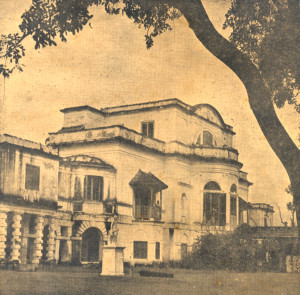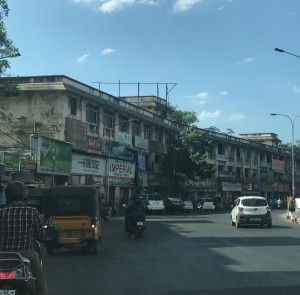Registered with the Registrar of Newspapers for India under R.N.I 53640/91
Vol. XXIX No. 5, June 16-30, 2019
Lost Landmarks of Chennai
- Sriram V
A Congress stronghold

THEN |

NOW |
|
Our Then is Blacker’s Garden, a colonial bungalow, dating to 1806 and |
|
A news item in the Swadesamitran dated December 22, 1940 informs us that the property named Blacker’s Gardens had become the office of the Tamil Nad Congress Committee the previous month. “This is a historic structure,” says the write up accompanying the photograph of the garden bungalow. “It was constructed by Lt Col. Blacker in 1806. He had joined the Madras Army in 1797. He participated in the Maratha wars and wrote copiously on them. In those days, the Europeans loved garden houses. The proximity of this property to Lord Cornwallis’ cenotaph was yet another reason for his choice. Until the laying out of Luz Church and Edward Elliots Roads, the powerful and famous would congregate in this area in the evenings. The popularity of the beach is more of a recent phenomenon.”
HD Love and his Vestiges of Old Madras, which were clearly the sources for the above tract, give some further details. Lt. Col. Valentine Blacker obtained a grant of nine acres of land on Mount Road in 1806. By 1813, he was Quarter Master General of the Madras Army. It appears from Love that there was an unfounded theory doing the rounds that this was the garden house that Arthur Wellesley had occupied while serving here in the 1790s. Love discredits the story by citing that the land was given for the first time only in 1806. Blacker moved to Calcutta as the Surveyor General of India in 1823. He died in that city in 1826 and is buried at the South Park Street Cemetery.
It would appear that Blacker’s Gardens in Teynampet changed hands after his departure to Calcutta or his subsequent death. There are no details as to who owned the property thereafter but we do know that the vast precinct was resided in by senior Government officials and in the 1920s came to be occupied by Sir Henry Cornish, Judge of the High Court of Madras, not to be confused with a journalist of the same name who ran the Madras Times. The property was at the eastern end of the Long Tank and therefore made for an ideal location for viewing the races organised by the Boat Club, which had then not yet moved to the Adyar. Beginning from 1875, competitive rowing events were held at the Tank until 1904, the distance being from ‘Cathedral Corner to Sydapet.’ The Regatta was of course the most important event and there would be 200 to 300 people present, including the Governor and his lady, with music, dancing and refreshments to follow. By 1920, boating on the Tank had ceased, the water being drained to make way for T Nagar but Blacker’s Garden remained a stately residence. The Swadesamitran photo depicts a rusticated and arched ground floor, a dominant curved central bay in the first floor, balconies covered by terracotta-tiled shades, a covered passageway and statuary. The top floor has an arched pediment.
By the 1930s, the Congress party was a powerful organisation. It was acquiring property in cities of India, these being funded by prominent industrialists and public donations. In 1935, at the time of the golden jubilee of the party, the Tamil Nad Congress Committee resolved to buy property of its own. The search began and received a powerful boost when C Rajagopalachari became the Premier of Madras Province that year. As per an account on the internet, which has the year completely wrong, Blacker’s Garden was more or less purchased by the well-known doctor T.S. Duraiswami Iyer when Rajaji approached him to give it up for the Congress. This may be true for the doctor was a prominent practitioner in the Mambalam area and the eponymous subway there is named after him. Anyway, the Congress Committee purchased Blacker’s Garden for a sum of Rs 80,000 in 1940 and moved in by early December that year. It is not clear who sold it, the purchaser being the Tamil Nad Congress Committee Charitable Trust.
The site became the venue for the famous Khadi and Swadeshi exhibitions of the Congress Party, held each December. The party also conducted a Carnatic Music festival at the same time, much to the distress of the Music Academy, which felt threatened. Ticket sales were good. The space was also let out for events and exhibitions organised by others and came to be known as Congress Grounds. As many musical and theatrical performances happened here, an amphitheatre too came up, though this was a temporary structure. During events, the age-old trees on the campus would be put to good use as supports for serial lights.
The Avadi Session of the Congress party in 1955 caused a major shakeup to the old-world charm of Congress Grounds. The redoubtable Ramnath Goenka of The Indian Express fame was in charge of money and also a key man in the arrangements. Though everyone had nothing but praise for the way the event was conducted, Ramnath Goenka, for reasons best known to himself, refused to submit accounts. Kamaraj was highly incensed but there was nothing to be done. In the event, there was a surplus and Goenka, who understood real estate like nobody else, suggested that a commercial complex be built on Congress Grounds. That probably necessitated the demolition of the old garden house that stood on the property. The new building, named Teynampet Congress Bhavan now Kamaraj Bhavan, has around 200 shops on three floors, the rents of which brought income to the party. The rest of the open space continues to be let out for events though its popularity as a venue has come down quite a bit chiefly owing to disruptions caused by the Metro. Now with the underground line becoming operational, the precinct may once again be in demand.
The open area came to be known as Kamaraj Thidal. It was on one part of this space that Kamaraj Memorial Hall/Arangam came to be built in 1991. Meant to seat 1,500 people, it has now become a very popular venue though architecturally it is at best a mediocre construction, a far cry from the striking building that Blacker’s Garden probably was. How many in the Congress would actually be aware of the property’s history today is open to question. But that they certainly are aware of its commercial value is quite clear from the plans that keep doing the rounds of bringing down the old commercial complex and putting up a high-rise on the site.
Our Then is Blacker’s Garden, a colonial bungalow, dating to 1806 and photographed in 1940. Our Now, is Kamaraj Bhavan, the shopping complex built on the same site in 1950 and whose graceful facade was designed to curve along the contours of Mount Road. We only wish it was better maintained, with uniform signage, some cleaning up, and a coat of paint.

